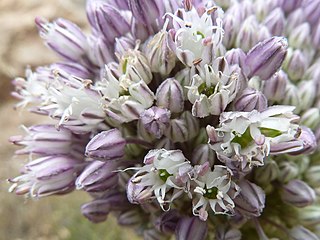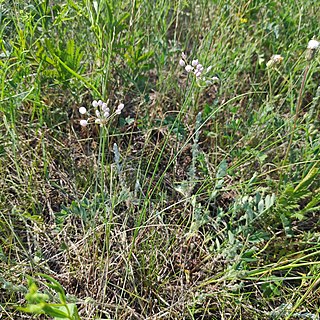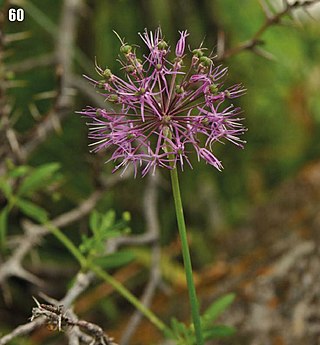
Allium ampeloprasum is a member of the onion genus Allium. The wild plant is commonly known as wild leek or broadleaf wild leek. Its native range is southern Europe to southwestern Asia and North Africa, but it is cultivated in many other places and has become naturalized in many countries.

Allium monanthum, the Korean wild chive, is a spring vegetable with minuscule bulbous roots that have a mild onion flavor and found in the woodlands of Korea, Japan, northeastern Russia (Primorye), and northeastern China.

Allium textile is a common species of wild onion found in the central part of North America.

Allium nevii, known by the common name Nevius' onion or Nevius' garlic, is a plant species native to central Washington and north-central Oregon in the United States. It grows in wet meadows and along stream banks at elevations up to 2000 m.

Allium anisopodium, also called thread-leaf chive, is a species of plant native to Siberia, the Russian Far East, Korea, Kazakhstan, Mongolia, and northern China.

Allium fetisowii is a plant species native to Kazakhstan, Uzbekistan, Xinjiang, Kyrgyzstan and Tajikistan in Central Asia.

Allium hookeri is a plant species native to India, Sri Lanka, Myanmar (Burma), Bhutan, and southwestern China. Common names include Hooker chives and garlic chives.
Allium inutile is a species of wild onion native to Honshu Island in Japan and to Anhui Province of southeastern China.
Allium korolkowii is a plant species native to Central Asia. It grows at elevations of 1500–2500 m.

Allium macranthum is an Asian species of wild onion native to Bhutan, Sikkim, Gansu, Shaanxi, Sichuan and Tibet. It grows in wet places at elevations of 2700–4200 metres.

Allium maximowiczii, English common name oriental chive, is an Asian plant species native to Siberia, the Russian Far East, Mongolia, Japan, Korea and northeastern China.
Allium phariense is an Asian species of wild onion native to mountainous areas of Bhutan, Sichuan, and Tibet. It grows at elevations of 4400–5200 m.
Allium plurifoliatum is a Chinese species of wild onion. It has been reported from Anhui, Gansu, Hubei, Shaanxi, and Sichuan at elevations of 1600–3300 m.

Allium sacculiferum, also called northern plain chive or triangular chive, is an East Asian species of wild onion native to Japan, Korea, eastern Russia, and northeastern China. It is found along the banks of lakes and rivers at elevations less than 500 m.

Allium sikkimense is a plant species native to Sikkim, Tibet, Bhutan, Nepal, India and parts of China. It grows in meadows and on the edges of forests at elevations of 2400–5000 m. The species is cultivated as an ornamental in other regions because of its strikingly beautiful blue flowers. It is used medicinally in the Sikkim Eastern Himalayas.
Allium spirale, also known as Korean aging chive, is a plant species native to Korea, Primorye, and parts of China. It is cultivated in many other regions and has for some reason obtained the common name German garlic. Other common names include spiral onion, corkscrew onion, and curly chives.

Allium thunbergii, Thunberg's chive or Thunberg garlic, is an East Asian species of wild onion native to Japan, Korea, and China. It grows at elevations up to 3000 m. The Flora of China recognizes A. tunbergii and A. stenodon as separate species, but more recent sources combine the two.
Allium tenuissimum is an Asian species of wild onion native to Mongolia, Asiatic Russia, Korea, Kazakhstan and China.
Allium tubiflorum is a plant species native to China at elevations less than 2000 m.
Allium yongdengense is a plant species native to the Gansu and Qinghai regions in China.











